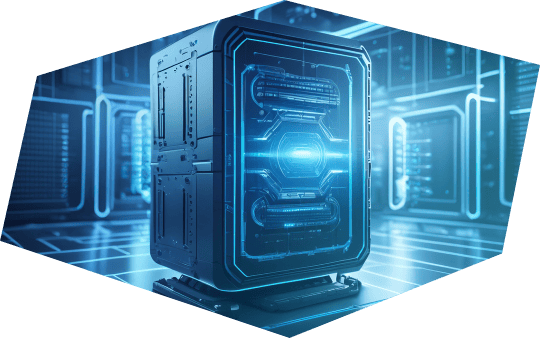
Data sovereignty, innovation, security:
Why German companies rely on edge computing
What is driving investment in edge computing in this country? Why do companies prefer to process their data locally, on servers or devices on the edge of the network, rather than centrally in a cloud data center? The latest gridscale study on “Edge Computing in Germany, Austria and Switzerland 2024” provides the first well-founded facts on companies’ motives for processing data locally. Dr. Andreas Stiehler, analyst and author of the study, summarizes the most important findings.
What are the motives for edge computing?
Does edge computing offer German companies the opportunity to implement innovative digitalization projects or is it just a stopgap solution for cloud-sceptical IT decision-makers? This question is still the subject of controversial debate in IT circles today – including in the gridscale Trend Report from 2023, which is based on extensive interviews with renowned edge and cloud computing experts. The result of our analysis at the time: both perspectives are justified, even if they initially appear contradictory. On the one hand, cloud migration has not yet been completed in many companies – particularly because many managers are still reluctant to relinquish control.
On the other hand, the cloud model is actually reaching its limits when it comes to implementing many innovative application scenarios – especially when it comes to processing mass data in real time at low cost. However, when the Edge Computing Trend Report 2023 was published, the reasons why companies continue to rely on decentralized data processing despite the wide range of cloud offerings remained unclear.
The gridscale study “Edge Computing in Germany, Austria and Switzerland” published in May 2024 now promises to shed light on this issue. It was based on a survey of more than 200 IT decision-makers in companies in the DACH region (50 employees or more) conducted by the analyst firm techconsult.
Edge computing: stopgap and innovation driver at the same time
Both motivations are similarly relevant for IT decision-makers today. The fact that many companies prefer local data processing is still linked to the desire for more control over their own data. As many as 46% of respondents rated this reason as “very important”. Correspondingly, many IT decision-makers want data processing to take place locally and independently of the internet connection. In this context, critical voices also speak of the “fear of losing control”.
The demand for infrastructure services provided locally by specialized data center operators in the vicinity of industrial parks and metropolitan areas is likely to increase noticeably in the coming months and years. This should also cause movement in the cloud/edge provider landscape. Finally, a new market for public edge services is maturing and needs to be evaluated.
At the same time, the majority of companies are now deliberately using the possibilities of edge computing to ensure a better user experience (UX), save costs or support the introduction of innovative real-time applications. The detailed analysis shows that a particularly large number of medium-sized and especially large companies are already using edge computing. This is hardly surprising, as larger companies have a much higher potential for automation and also have more resources for implementing innovative digitalization solutions than smaller players.
The dynamic development of AI is the most important driver here. More than 20 percent of respondents (45 out of 201) explicitly refer to investments in the AI environment when asked openly which innovative solutions with edge computing requirements are currently being planned and implemented. Many other responses point to dynamic innovation in areas such as Industry 4.0, IoT, robotics, smart health and smart cities, where AI is an integral part of the solution.
“Very important” as a reason for local IT infrastructure operation (by company size)
▮ Introduction of innovative digitalization solutions with high bandwidth requirements and latency requirements (AI, IoT, etc.)
▮ Introduction of innovative digitalization solutions with high bandwidth requirements and latency requirements (AI, IoT, etc.)
Source: techconsult on behalf of gridscale GmbH, April 2024 | Basis: 201 companies in the DACH region, rounding differences possible
Auszug aus den offenen Nennungen zu »innovativen Anwendungsszenarien, die derzeit in Planung / Umsetzung sind und Edge Computing erfordern« +++ intelligente Fertigung und Optimierung der Produktionsprozesse durch Analyse der Produktionsdaten in Echtzeit +++ intelligente Gebäude durch Sensordaten für Raumtemperatur und Beleuchtung sowie für Zutrittskontrollen zu Gebäuden +++ Steuerung von elektrischen Einrichtungen +++ digitaler Zwilling +++ RFID-Verfolgung von Produkten +++ verbesserte Lagerhaltung und Überwachung der Produktion +++ Data Management, Data Marketplace, Data Fabric +++
In a nutshell: The study results so far confirm that both the desire for control over one’s own data and enhancing digital efforts are key motivations for local data processing in the sense of edge computing.
Edge computing also scores points for security and data protection
But that’s not all, the results of the survey also point to a third key motivation: security and compliance. In fact, “higher security” ranks at the top of the list of reasons for local data storage that are classified as “very important” at 53 percent. In addition, a significant proportion of companies refer to regulations regarding data residency.
In the open responses on specific reasons for local data storage, numerous participants also (explicitly or implicitly) referred to security aspects – whereby various added values of edge computing with regard to data security and data protection were highlighted:
- Local encryption: Edge computing, as is repeatedly stated, offers the option of local encryption of data – before some of it is then sent in anonymized form to a central cloud for further processing.
- Backup options: Some participants referred to the use of edge computing resources (e.g., on on-site devices) to create local backups to ensure rapid recovery of systems in the event of failure.
- Reliability and redundancy: As there is no need to transfer data to the central cloud, this not only reduces costs but also the risks associated with an internet connection failure. There is also the option of setting up redundant data processing systems at local level. If one device fails, another can take over.
- Less security weak points: Overall, various IT decision-makers argue that local data processing can significantly reduce the weak points of data security for cyber criminals.
- Guidelines: Finally, numerous survey participants refer to legal, industry or company-specific regulations and guidelines that expressly provide for local processing of sensitive data.
Gründe für lokale Infrastruktur – Auszug aus den offenen Nennungen +++ Gewährleistung der Sicherheit, die Überschaubarkeit der Infrastruktur, Verschlüsselungsmöglichkeit sensibler Daten +++ jederzeit Zugriff auf wichtige Dateien, jederzeitige Möglichkeit der Optimierung durch umfangreiche Analyse +++ niedrige Latenzzeiten und eine schnellere Reaktionszeit für Anwendungen wie loT, Industrie 4.0 oder Automatisierung +++ Die Einhaltung der gesetzlichen Vorgaben und der Datenschutz +++ Anwendungen, die eine schnelle Reaktionszeit erfordern, wie zum Beispiel loT-Geräte +++ Backup-Möglichkeiten und Datensicherheit+++
Conclusion: companies need a well-founded edge / cloud strategy
Overall, the results of the study tells us to avoid sweeping judgments when evaluating market developments in the cloud/edge environment. The question discussed at the beginning of this article as to whether edge computing serves companies more as a stopgap solution for cloud sceptics or as a driver of innovation cannot be answered unequivocally even after analyzing the study results. In most companies, both a pronounced need for control on the part of IT decision-makers and the pressure to support AI-based digitalization solutions obviously play an important role in the decision to operate a local infrastructure. There are also security and data protection aspects.
In fact, companies today are facing a serious restructuring of their infrastructure operations, whereby the focus is no longer solely on cloud migration, i.e. the transfer of workloads to central data centers. IT decision-makers are also required to realign and, if necessary, expand local data processing options. The target should be to support innovative application scenarios with the best possible combination of computing resources within the cloud edge continuum.
To achieve this goal, companies need a well-founded edge/cloud strategy. Based on future application scenarios, it is important to define a suitable architecture mix for processing different workloads – taking into account technical, business and legal factors as well as security and data protection aspects (as explained in this spotlight analysis).

Dr. Andreas Stiehler
As an IT analyst, author and consultant, Dr. Andreas Stiehler has been supporting research and consulting projects on digital change for more than 20 years. His core topics are Digital Work Digital Workplace, customer service in the digital transformation and the management of knowledge work(ends). With a doctorate in economics and a focus on behavioral economics, he is committed to taking a holistic view of digital change and placing a stronger focus on the human beings.
Profile on LinkedIn
The future of enterprise software: AI agents are coming
The future of business software: The AI agents are coming! A new…

